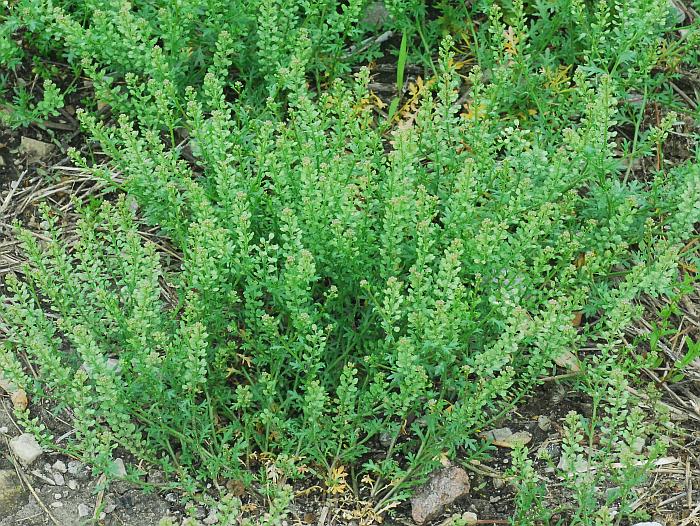Lepidium oblongum Small
Stinking Pepperweed

Introduced
CC = *
CW = 5
MOC = 6
© SRTurner
Lepidium oblongum SmallStinking Pepperweed | |
 |
Introduced CC = * CW = 5 MOC = 6 |
© SRTurner |
|
Family - Brassicaceae Habit - Annual forb. Stem - Ascending to erect, to 30 cm, often branched, pubescent with papillate hairs.
Leaves - Basal and alternate. Basal and lowermost stem leaves 3.0-7.0 cm long, 2 or 3 times pinnately divided with oblong divisions. Upper stem leaves 1.0-2.0 cm long, pinnatifid or laciniate, oblanceolate to linear, sessile, the bases not auriculate, sparsely pubescent.
Inflorescences - Elongate racemes, the rachis with papillate hairs, bracts absent.
Flowers - Sepals 4, 0.7-1.0 mm long, oblong. Petals absent or present and 0.1-0.7 mm long, white. Stamens 2. Styles to 0.1 mm long.
Fruits - Silicles 2.2-3.5 mm long, nearly circular, widest at the middle, the tip shallowly notched and relatively narrowly winged, flattened, glabrous, the stalks pubescent all around. Seeds 1.2-1.6 mm long, ovate, not winged, the surface with a minute, netlike pattern, brown.
Flowering - April - May. Habitat - Open disturbed areas. Origin - Native to the U.S. Lookalikes - Other members of the genus. Other info. - This weedy species was first collected in Missouri by James Sullivan, in 2002, at a truck stop. It was initially determined as L. ruderale, an Old World species which has been found in scattered locations in the U.S. The specimen was later redetermined as L. oblongum Small by Brassicaceae expert Ihsan Al-Shehbaz. Since the initial report, the plant has been found in several other counties, always in highly disturbed spots. Beyond Missouri, the plant occurs mostly in states to the south and west. Although it is native in most parts of the U.S., populations in Missouri are considered introduced. Photographs taken at the Dutzow Katy Trailhead, Warren County, MO, 5-7-2013, in West Alton, St. Charles County, MO, 4-29-2016, and along the Katy Trail near Treloar, Warren County, MO, 5-2-2020 (SRTurner). |